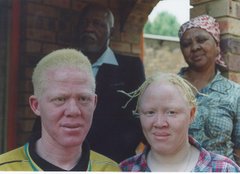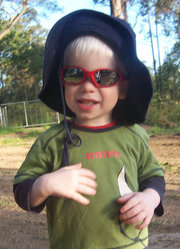Albinism
Albinism (from Latin albus, meaning "white") is a lack of pigmentation in the eyes, skin and hair. It is an inherited condition resulting from the combination of recessive alleles passed from both parents of an individual. This condition is known to affect mammals, fish, birds, reptiles, and amphibians. While the most common term for an individual affected by albinism is "albino", some of them prefer "person with albinism", because "albino" is often used in a derogatory way. more...
A humorous compensation for this was the invention of the word "pigmento" for a normally pigmented person. The gene which results in albinism prevents the body from making the usual amounts of a pigment called melanin. Albinism used to be categorised as Tyrosinase positive or negative. In cases of Tyrosinase positive albinism, the enzyme tyrosinase is present but is unable to enter pigment cells to produce melanin. In tyrosinase negative cases, this enzyme is not produced. This classification has been rendered obsolete by recent research.
About 1 in 17,000 people have some type of albinism, although up to 1 in 70 are carriers.
There are many genes which are now scientifically proven to be associated with albinism (or better: alterations of the genes). All alterations, however, lead to an alteration of the melanin (pigment/coloring) production in the body. Melanin helps protect the skin from ultraviolet light coming from the sun (see human skin color for more information). Organisms with albinism lack this protective pigment in their skin, and can burn easily from exposure to the sun as a result. Lack of melanin in the eye also results in problems with vision unrelated to photosensitivity, which are discussed further below.
There are two main categories of albinism in humans: oculocutaneous and ocular. In ocular albinism, only the eyes lack pigment. In oculocutaneous pigment is missing from the hair, eyes, and skin. People who have ocular albinism have normal skin/hair color and many have normal eye color. People with oculocutaneous albinism can have no pigment to almost normal. Some may even tan.
The eyes of a person with albinism occasionally appear red due to the underlying blood vessels showing through where there is not enough pigment to cover them. In humans this is rarely the case, as a human eye is quite large and thus produces enough pigment to lend opacity to the eye. However, there are cases in which the eyes appear red or purple, depending on the amount of pigment present.
Vision aside, people with albinism are generally as healthy as the rest of their species, with growth and development occurring as normal. Many animals with albinism, however, lose their protective camouflage and are unable to conceal themselves from their predators or prey. The survivability rate of animals with albinism in the wild is usually quite low. The largest problem people with albinism face is social, as the condition usually is a source of torment during adolescent years.
As albinism is a recessive gene, the chance of offspring with albinism resulting from the pairing of someone/thing with albinism with something/one without albinism is very low and is discussed below.
Read more at Wikipedia.org




